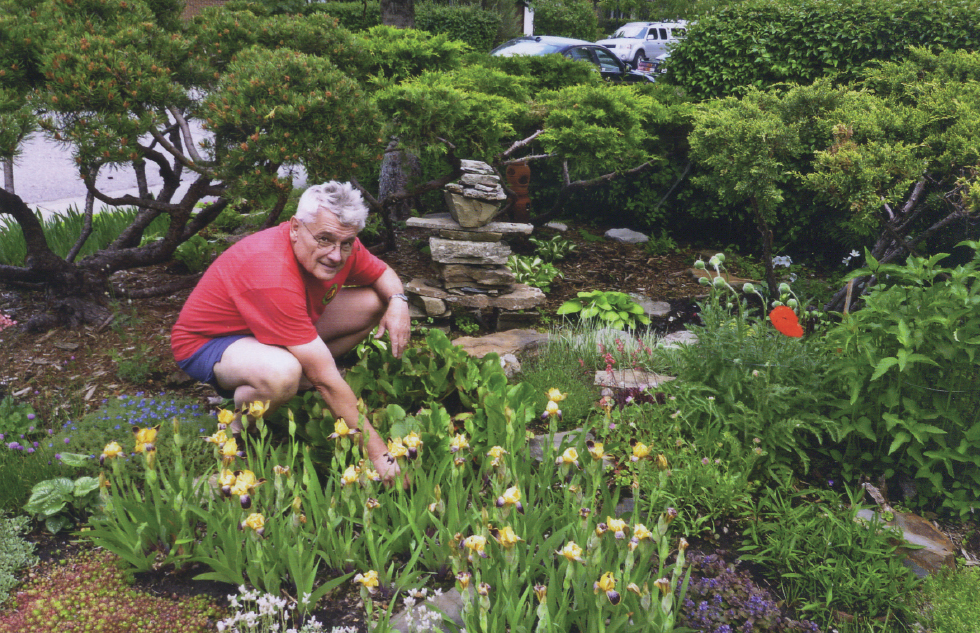You don’t have to be a horticulturalist to have a nice garden!

Photo by Jerry Cvach
Already in my teen years while living in Czechoslovakia I was “into” rock gardens.
My father built a cabin in a rustic village on a lot that for many years had been a source of clay for the locals to make their own adobe bricks. The entire property was an old pit cut into the side of a hill. Behind the cabin, the slope had to be terraced and stabilized by rocks and retaining parapets. The soil was pure clay, ideal for brick making but terrible for gardening. The only things we could grow were rockery plants and a few birch and pine trees.
Short after my wife Judy and I came to Canada 40 years ago, we bought our current house. We had the builder bring us a few extra loads of loam to build a mound on our flat front yard to make a small rock garden on the slope facing the house. Since we wanted to blind into the neighbourhood, we graded the other side of the slope more gradually and put down some sod. In due time, the grass figured out that we knew nothing about growing lawns (since we were not English) so we started to bring in more rocks from our hiking expeditions. The lawn was eventually converted into a rockery and it now covers the front yard all the way to the sidewalk. Even in the backyard, the lawn was replaced by a perennial garden and a large wooden patio.
The front yard is my domain while my wife prefers the privacy of the back. As a result, the two gardens are quite different. Judy’s is orderly and always immaculate while mine is.
Well.
Different.
For one thing, she can grow hens-and-chickens better than anyone I know. She has zillions of them and we call her “netreskova baba” (loosely translated as hens-and-chickens granny).
When I woke up on the first official day of spring and looked out of the living room window, my rock garden was still looking very sad indeed. However, in only a few weeks it will change dramatically. Perennial gardens, in general, are very good that way. Unlike the annuals that need time to develop their full glory, perennials flower profusely right from the start.
Even though they bloom just once in the year, and last for one to three weeks, they do this at different times. The primulae and phloxes arrive first and the irises follow.
Then come the lilies, Echinacea, hostas and — last of all — the asters. There are others in between, too many to list. The appearance of the garden changes daily. It seems like a mad rush from the get-go to the finish in October.
I love gardening: the challenges, creativity and beauty of it. But I’m not a gardener in any proper and well-educated sense, not even a good one. I don’t know what I’m doing, don’t know the English names of most of my plants and in Latin not at all; particularly not of those plucked from the wilds. I’ve no idea how to make them really happy.
If a plant doesn’t prosper, I give it a second chance by moving it a little distance away. This is surprisingly effective in many cases. Sometimes I may bribe the plant a bit with some sea soil or compost. If that doesn’t help, they get the boot and are replaced by something else. And the experimentation continues.
There was a time when I was ambitious and studied gardening manuals, but found their instructions and suggested remedies confusing and ineffective. When the experts don’t recommend watering more, they recommend watering less and there is always some problem with the soil.
So I water, fertilize and weed or trim my bushes when I have time. If my plants don’t like the soil, I mix in more from whatever bag of miracle soil I have on hand because it was on sale. The kind doesn’t matter: if it is nutritious, it usually helps.
One outcome from the use of different soil can be surprising. The hens-and-chickens in particular tend to change their colour and sometimes even their appearance.
One unwanted outcome of my ignorance is that I’m evasive when those passing by ask advice. I give an off-hand reply and they think me haughty.
After all those years and a great deal of stubbornness on my part, though, the plants that survive the treatment and thrive are now outnumbering the experimental ones and the yard is starting to look darn good. To the point that a sneaky member of our community garden enthusiasts, God bless her soul, nominated me one year for their annual competition without my knowledge.
I won the first prize, I believe, for the “Curb Appeal.”
The judging was done by a Garden Centre employee and the only criticism was that the garden hose and tools weren’t put away on the day of judging. Serves them right, they should have told me!
Our house is close to an off-leash area and we get a lot of traffic from the dog people, who are a happy breed — the people, not the dogs — and they make encouraging comments. It was one of the ladies who observed that the changeability of my perennial garden makes her daily walk enjoyable. We derive a great deal of satisfaction from gardening, one of the last vestiges of simpler times before electronics. It doesn’t take much know how or much money, but a little bit more of your time.
It is not complicated. I bet you can do it too, and moreover, that it’s worth it!
